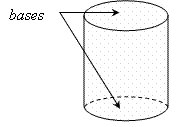 username@email.com
username@email.com
Now we’ll look at some other solids and how to calculate their volumes, surface areas, and other characteristics. We’ll also present some more questions and give you a chance to practice these skills.
Recall that the surface area of a polyhedron is the sum of the areas of its polygonal faces. The surface area of a cylinder is the sum of the areas of its faces, as well. Clearly, the two bases are circles, but the other “face” is harder to see. This might help:

So, the surface area of a cylinder is given by the formula A = 2πr2 + 2πrh, where r is the radius of the circular bases and h is the height.
What is the surface area of a cylinder with a base of radius 2 ft and a height of 3 ft? Give your answer in terms of π and round your answer to the nearest square foot.
Choice D is the correct answer. The surface area of this cylinder is equal to A = 2πr2 + 2πrh, where r = 2 ft and h = 3 ft. The surface area is:

Let’s start with a diagram of a cone so that you can get some sense of where the formula for its surface area comes from.

The surface area of a cone is given by the formula, A = πr2 + 2πrl, where r is the radius of the base and l is the slant height.
Recall that a sphere is the set of all points in space that are equidistant from a given point. That equal distance is the radius of the circle. This makes things simpler, because everything about a sphere depends on its radius. And so the formula for its surface area depends only on its radius.

What is the surface area of sphere with diameter 8 yd? Round your answer to the nearest square yard.
Choice C is the correct answer. The surface area of the sphere is given by the formula A = 4πr2, where r = 4 yd. If you picked choice D, you may have used 8 yd for the value of the radius rather than the value of the diameter. Remember, everything about a sphere depends on its radius, so the most common way to mix up a circle or sphere problem is to give the diameter instead of the radius. Please be careful. The sphere has surface area equal to:

Got your fill of formulas yet? The surface area formulas for polyhedra are quite intuitive; the surface area formula for a cone is not. Or is it?
Recall that the volume of a prism is V = Bh, where B is the area of the base and h is the height. The same is true for cylinders, except now the base is a circle. So B = πr2.

What is the volume of a cylinder of height 10 in. and radius 15 in.? Give your answer in terms of π and round to the nearest cubic inch.
Choice B is the correct answer. The volume of the cylinder is given by the formula V = πr2h, where r = 15 in. and h = 10 in. The volume of the cylinder is

Recall that the volume of a pyramid is one third of the volume of a prism with the same base and height. The same relationship is true for cylinders and cones.

 Where r is the radius of the circular base and h is the height.
Where r is the radius of the circular base and h is the height.
What is the volume of a cone whose height and radius each equal 1 yd? Give your answer in terms of and round to the nearest cubic yard.
 yd3
yd3 yd3
yd3Choice A is the correct answer. The volume of the cone is given by the formula  , where r = 1 yd and h = 1 yd. The volume of the cone is
, where r = 1 yd and h = 1 yd. The volume of the cone is

Recall that everything about a sphere depends on its radius. Also recall that volume is measured in cubic units. These two facts take us some of the way to the formula for the volume of a sphere.

 , where r is the radius of the sphere.
, where r is the radius of the sphere.
Let’s try a practice question and then we’ll look at some other examples of these formulas.
What is the volume of a sphere of radius 3 cm? Round your answer to the nearest cubic centimeter.
Choice C is the correct answer. The volume of the sphere is given by the formula  . Plug 3 in for the radius and solve.
. Plug 3 in for the radius and solve.
 , where r is the radius of the circular base and h is the height.
, where r is the radius of the circular base and h is the height. , where r is the radius of the sphere.
, where r is the radius of the sphere.